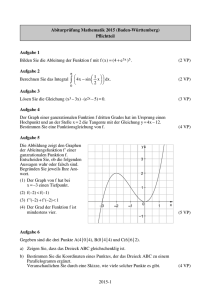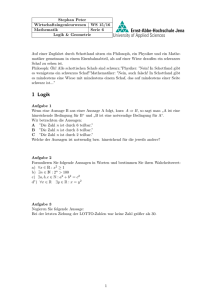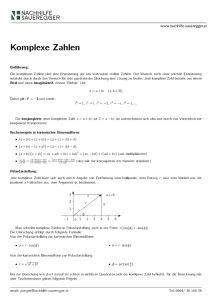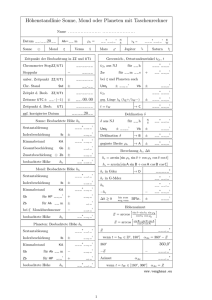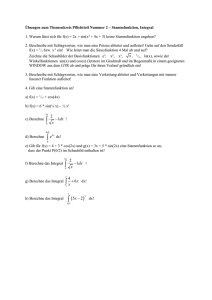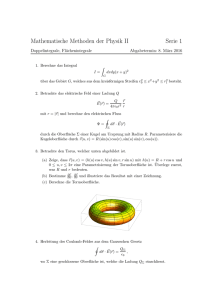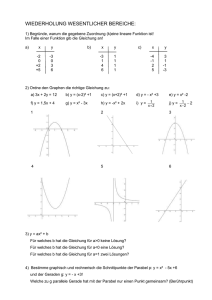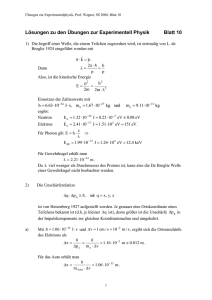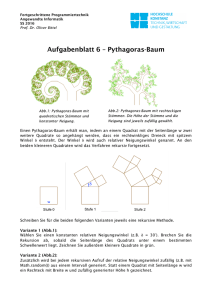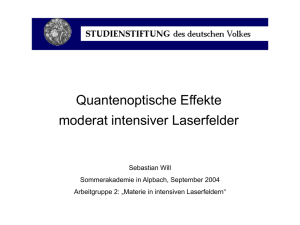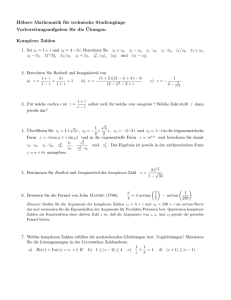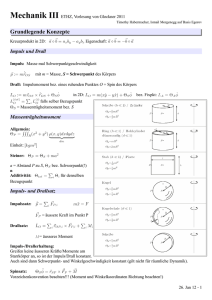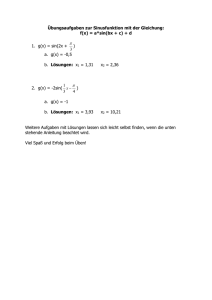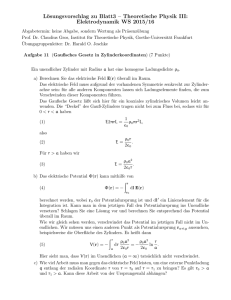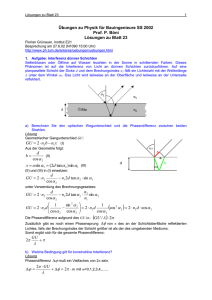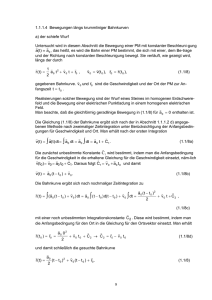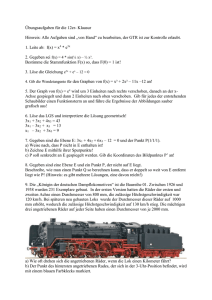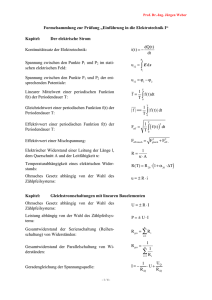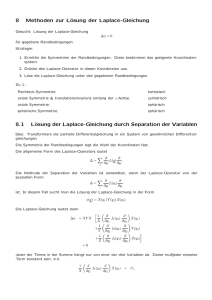Meine Analysis III Zusammenfassung ()
Werbung
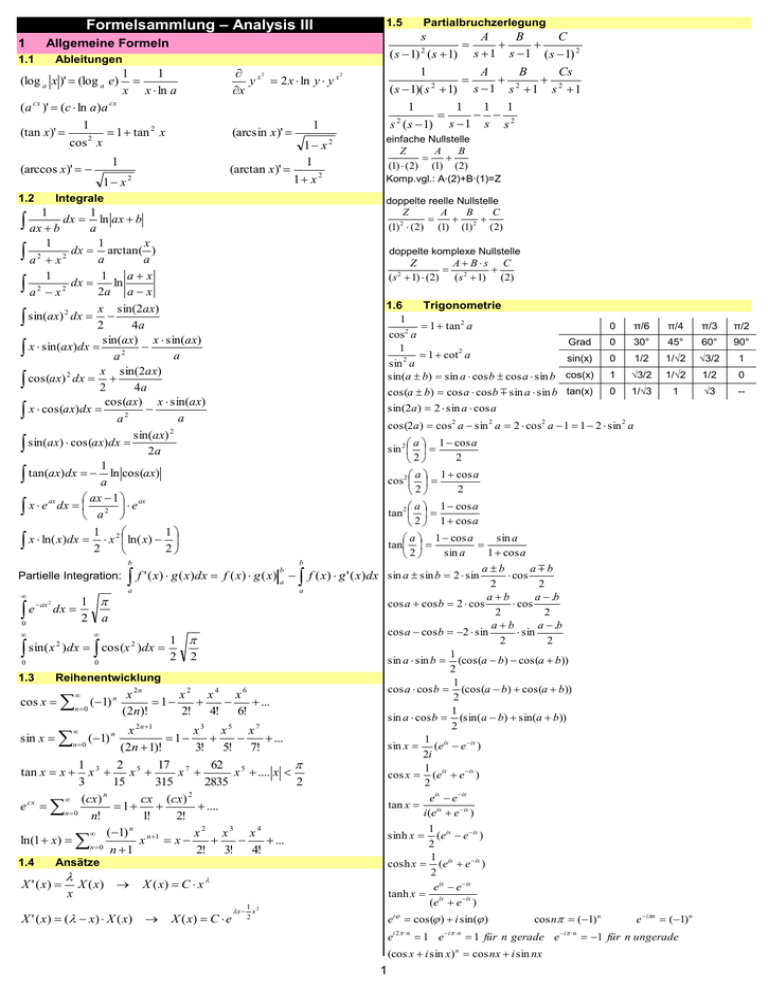
Formelsammlung – Analysis III
1
1.2
2
1 x 2
1
(arctan x)'
1 x 2
1 x 2
2
1
(arcsin x)'
1
(arccos x)'
x
y 2 x ln y y x
x
1
1
x x ln a
(a cx )' (c ln a)a cx
1
(tan x)'
1 tan 2 x
cos 2 x
A
B
C
( s 1) ( s 1) s 1 s 1 ( s 1) 2
1
A
B
Cs
( s 1)( s 2 1) s 1 s 2 1 s 2 1
1
1
1 1
2
2
s ( s 1) s 1 s s
2
Ableitungen
(log a x )' (log a e)
Partialbruchzerlegung
s
Allgemeine Formeln
1.1
1.5
Integrale
einfache Nullstelle
Z
A
B
(1) (2) (1) (2)
Komp.vgl.: A∙(2)+B∙(1)=Z
doppelte reelle Nullstelle
1
1
dx ln ax b
ax b
a
1
1
x
dx arctan( )
a
a
a2 x2
1
1
ax
dx
ln
2a a x
a2 x2
x sin(2ax)
sin(ax) 2 dx
2
4a
sin(ax) x sin(ax)
x sin(ax)dx
a
a2
x sin(2ax)
2
cos(ax) dx
2
4a
cos(ax) x sin(ax)
x cos(ax)dx
a
a2
sin(ax) 2
sin(ax) cos(ax)dx
2a
1
tan(ax)dx ln cos(ax)
a
ax 1
x e ax dx 2 e ax
a
1
1
x ln( x)dx x 2 ln( x)
2
2
Z
A
B
C
(1) 2 (2) (1) (1) 2 (2)
doppelte komplexe Nullstelle
Z
A Bs C
( s 2 1) (2) ( s 2 1) (2)
1.6
Trigonometrie
1
1 tan 2 a
cos2 a
1
1 cot 2 a
sin 2 a
sin(a b) sin a cos b cos a sin b
cos(a b) cos a cos b sin a sin b
sin(2a ) 2 sin a cos a
π/6
π/4
0
30°
45°
60°
90°
0
1/2
1/√2
√3/2
1
cos(x)
1
√3/2
1/√2
1/2
0
tan(x)
0
1/√3
1
√3
--
a 1 cos a
sin 2
2
2
a 1 cos a
cos2
2
2
X ' ( x ) ( x ) X ( x )
X ( x) C e
x x
ei cos( ) i sin( )
2
cos n (1) n
e in (1) n
ei 2 n 1 e i n 1 für n gerade e i n 1 für n ungerade
(cos x i sin x) n cos nx i sin nx
1
π/2
Grad
cos(2a ) cos2 a sin 2 a 2 cos2 a 1 1 2 sin 2 a
π/3
sin(x)
a 1 cos a
tan 2
2 1 cos a
sin a
a 1 cos a
tan
2
sin
a
1
cos a
b
b
ab
ab
b
cos
Partielle Integration: f ' ( x) g ( x)dx f ( x) g ( x) a f ( x) g ' ( x)dx sin a sin b 2 sin
2
2
a
a
a
b
a
.b
2
1
cos a cos b 2 cos
cos
e ax dx
2
2
2 a
0
ab
a .b
cos a cos b 2 sin
sin
2
2
1
sin( x 2 )dx cos(x 2 )dx
1
2
2
sin a sin b (cos(a b) cos(a b))
0
0
2
1.3
Reihenentwicklung
1
cos a cos b (cos(a b) cos(a b))
2n
x2 x4 x6
n x
2
cos x n 0 (1)
1
...
1
(2n)!
2! 4! 6!
sin a cos b (sin( a b) sin(a b))
2
x 2 n 1
x3 x5 x7
n
sin x n 0 (1)
1
...
1 ix
sin x (e e ix )
(2n 1)!
3! 5! 7!
2i
1 3 2 5 17 7
62 5
1
tan x x x x
x
x .... x
cos x (eix e ix )
3
15
315
2835
2
2
n
2
eix e ix
(
cx
)
(
cx
)
cx
tan x ix
e cx n 0
1
....
i (e e ix )
n!
1!
2!
n
1
( 1)
x2 x3 x4
sinh x (eix e ix )
ln(1 x) n 0
x n 1 x
...
2
n 1
2! 3! 4!
1
1.4
Ansätze
cosh x (eix e ix )
2
X ' ( x) X ( x) X ( x) C x
eix e ix
tanh x ix
x
(e e ix )
1 2
0
2
2.1
PDGen
5
Seperation der Variablen
Ansatz: u( x, t ) X ( x) T (t )
Die Wellengleichung
1
Problem:
utt u xx 0
c2
Allg. Lösung: u ( x, t ) F ( x ct ) G ( x ct )
Beispiel:
Allg. Lösung des Anfangswertproblems:
1
c 2 u tt ( x, t ) u ( x, t ) 0
u ( x,0) f ( x)
1
1
u ( x,0) g ( x) u ( x, t ) f ( x ct ) f ( x ct )
t
2
2c
Gesucht: Lösungen der Form: u( x, y) f ( x) g ( y)
1. f ' ' ( x)
g ' ' ( y)
C
f ( x)
g ( y)
2.1.1
x ct
x ct
g ( y ) dy
2.
Beispiel Wellengleichung Prüfung F05
4u tt u xx e t
u ( x,0) 0
u ( x,0) 0
t
3. aus (*) folgt, daß f (0) f ( L) 0 gilt. Nur die Lösung für C<0
macht Sinn für diese Forderung.
4. Es folgt A = 0 und aus B sin( C L) 0 , daß
k x
f ( x) B sin(
)
L
5. da C< 0 ist g ( y) D e k y L E e k y L
6. aus u ( x,0) 0 folgt daß g (0) 0 also D E
k y
k x
) sinh(
)
3
L
L
K
sinh(4 )
8. aus einsetzen folgt noch daß k 4 und
3
4 x
4 y
9. Die Lösung ist also
u ( x, y)
sin(
) sinh(
)
sinh(4 )
L
L
6
Inhomogene PDGlen
2.2
Wärmeleitungsgleichung
Problem: u u 0
xx
u ( x,0) f ( x)
1. Fouriertransformierte:
1
uˆ (k , t )
u( x, t ) e ikx dx
u ( x, t )
uˆ ( x, t ) e ikx dk
2
1
2. Ableiten: u t ( x, t )
uˆ t ( x, t ) e ikx dk
2
1
u xx ( x, t )
uˆ ( x, t ) k 2 e ikx dk
22
k
3. Einsetzen: uˆ (k , t ) k uˆ(k , t ) 0 uˆ(k ,0) fˆ (k ) uˆ(k , t ) fˆ (k )e
4. Rücktrafo: u ( x, t )
1
4 t
u t au xx sin x t 0, x R
u ( x,0) 0 x R
f ( x' ) e
Wärmeleitungskern Kt: K ( x x' )
t
Lösung: u( x, t )
Die allg. Lösung eines inhomogenen Randwertproblems ist die allg.
Lösung des zugehörigen homogenen Problems plus eine partikuläre
Lösung des inhomogenen Problems.
Beispiel:
( x x ') 2
4t
1
4 t
e
2
t
Vorgehen:
1. u ( x, t ) u H ( x, t ) u P ( x, t )
2. Finde partikuläre Lösung
3. Setze diese in AB ein
4. Löse das homogene Problem
5. Zusammensetzen
dx'
( x x ') 2
4t
K t ( x x' ) f ( x' )dx'
Lösungsweg:
1.
sin x
a
f f g f h
Kettenregel: f ( g ( x), h( x))
1
0
2. t 0 u ( x,0) u H ( x,0)
x g x h x
a sin x
x
r
cos
y
r
sin
f ( x, t ) f (r ( x, y), ( x, t )) Polarkoordinaten
1
u H ( x,0)
( f ( x))
f ( x, y)
a sin x
Was ist
in Polarkoordinaten?
x
(u H ) t a (u H ) xx 0
r r
x y
sin
cos
sin Inverse x y cos
r 4. u H ( x, t ) K t ( x x' ) f ( x)dx'
r r
R
cos
x y r sin r cos
x y sin
r
1
sin x
K t ( x x' ) f ( x)dx'
5. u ( x, t )
a R
a
4
Superposition
3
C L k , also
7. u ( x, y) K sin(
1
t 1
t 1 et 1 t
u ( x, t ) x x
e t 1
4
2 4
2 4 4 4
t
A e C x B e C x (C 0)
f ( x) A cos( C x) B sin( C x) (C 0)
A x B (C 0)
D e C y E e C x (C 0)
g ( y ) D cos( C y ) E sin( C y ) (C 0)
D y E (C 0)
t
t et
u ( x, t ) u h ( x , t ) u p ( x , t ) F x G x
2
2 4
1
ableiten
u ( x,0) F ( x) G ( x) 0
u ' ( x,0) F ' ( x) G ' ( x) 0
4
1
1
1
u t ( x,0) F ' ( x) G ' ( x) 0
2
2
4
x
F ( x) 4 C
1
F ' ( x)
x 1
4
G ( x) C
4 4
u xx u yy 0
u (0, y ) u ( L, y ) 0 (*)
u ( x,0) 0 L 0
u ( x, L) 3 sin 4 x
L
Koordinatentransformation
0 a u p ' ' sin x u p
Lineare PDG hat die Form Lu=b, wobei L Diffentialoperator und b eine
gegebene Fkt der unabh. Variablen ist. Homogen, wenn b=0.
Sind u1,…,un Lösungen der linearen PDG Lu=0, so ist auch jede
Linearkombination u=c1u1+…..+cnun eine Lösung.
2
7
Fourier-Reihen
7.1
8
f ( x)
n
2in
x
L
cn e
1
cn
L
mit
L
0
e
2in
x
L
f ( x)dx
f(x) sei eine zweimal stetig differenzierbare L-periodische Funktion
Beispiel von periodischen Fkten:
2π-periodische Fkten: cos(x), sin(x), eix
L-periodische Fkten:cos(2πx/L), sin(2πx/L), ei 2πx/L
L, L/n periodische Fkten: (2πnx/L), sin(2πnx/L), ei 2πnx/L
Integrationsintervall
Man kann auf beliebigem Intervall der Periodenlänge integrieren:
L
La
a
L
... ... ... ...
0
a
0
2
fˆ (k ) f ( x) e ikx dx
f ( x) e ax
fˆ ( x)
k2
0
x
cn
1
2
1
2
1
2
L
f ( x) e
dx
1
2
1
e
0
0
1 1 inx
e inx dx
e
2 2 ni in
1
e in e in e 0
für n ungerade : e in 1 c n
0
1 inx
e
in
0
2
2n2
L/2
L / 2
L/2
L / 2
f ( x) 0
L/2
f ( x) 2 f ( x)
0
2 L2
2n
f ( x) sin
x dx
l
2
L
L
2n
b sin
x
n 1 n
L
4 L2
2n
bn
f ( x) sin
x dx n 1
L 0
L
a
2n
x
Gerade Funktion: f ( x ) 0 n 1 a n cos
2
L
a
Ungerade Funktion: f ( x) 0
2
4
an
L
L 2
0
e
e
ik
a x
2a
2n
f ( x) cos
x dx n 0
L
ikx
dx
2
k2
dx e 4 a
e
2
ik
k2
a x
2a 4a2
dx
k2
e ay dy e 4 a
2
f ( x ) e ikx dx1 ...dxn
en ax e ikx dx
2
e
( ak 2 bk c )
e
x2
1
dk
1 k 2
n
2 2e
a
2n
2n
f ( x) 0 n 1 a n cos
x bn sin
x
2
L
L
2 L2
2n
a n f ( x) cos
x dx
L l 2
L
bn
n
7.2
Reelle Darstellung
reellwerte Lösungen sind Spezialfälle von komplexen Lösungen
Ein Fkt auf R ist: gerade falls f(-x)=f(x) und ungerade falls f(-x)=-f(x)
Produkt:
gerade mal gerade = gerade
ungerade mal ungerade = gerade
ungerade mal gerade = ungerade
Falls f(x) gerade ist, dann
e
ax 2
in
2 2 n 2
2 2 n 2
in
für n gerade : e
1 cn 0
Falls f(x) ungerade ist, dann
2
a
f ( x)
1
2
n
fˆ (k ) e ikx dk1 ...dk n
Nützliche Rechnungen:
e inx dx
fˆ ( x) e ikx dk
Eine Fkt f: R in C nimmt genau dann ihre Werte in R an, wenn
Fouriertransformierte folgende Relation erfüllt: fˆ (k ) fˆ (k )
0
fˆ (k )
2
1 1
2 ni
In n-dimensionalen Räumen:
x
1 e inx dx
0
0
0
x inx
x
1 e dx 1
1 e inx dx partielle Integr :
2 0
0
0
x
1 inx
1 1 e inx dx
e
1
in
in
0
0
x
1 1
1 inx
inx
in e 1 in e dx
1
L
2in
x
L
e 4a
2 periodisch
Beispiel:
nützlich : ... ...
a
1
2
f ( x)
Beispiel
f ( x) 1
Fouriertransformation
PDG auf endlichem Intervall → Fourierreihen
Lin. PDG auf unendlichem Intervall → Fouriertransformation
L unendl. groß, L → ∞, Δk=2π/L → 0, Summe → Integral
Komplexe Darstellung
n
a
dk
e
a
k2
4a
e
ˆ
fˆ ( x) 2 fˆ ( x)
b2
c
4a
dx
Anleitung: (für inhom. DGl. mit AB)
i) Fourriertrafo der DG mit fn=(ik)nf^
ii) Lösen der DG
iii) Fourriertrafo der AB
iv) AB in DG einsetzen
v) Rücktrafo
8.1
Wärmeleitungsgleichung
AWP: u t ( x, t ) u xx ( x, t ) 0
u ( x,0) f ( x)
i) Fourriertrafo der DG: uˆt (k , t ) (ik ) u(k , t ) 0
2
ii) Lösen der DG: uˆ (k , t ) C e k
iii) Fourriertrafo der AB: fˆ (k )
t
2
f ( x) e ikx dx
iv) AB in DG einsetzen: uˆ (k , t ) fˆ ( x) e
v) Rücktrafo: u ( x, t )
1
2
k 2 t
2
fˆ ( x) e k t ixk dk
u( x, t ) Kt ( x x' ) f ( x' )dx'
Lösung:
Mit Wärmeleitungskern: K t ( x x' )
Mit:
K ( x x' )dx 1
t
K t ( x x' ) 0
Inhomogen:
part. Lösung mit rechter Seite
u(x,0)=part.+gegeb. Lösung
in AWP dafür homogen (=0)
neues f(x)
Lösen wie oben
3
1
e
4t
( x x ') 2
4t
9.1
Beispiele
Beispiel A
Laplacetransformation
9
F ( s)
f (t )e
st
dt
AWP:
0
xt (t ) 2 x(t ) t
x ( 0) a
Linearität
i) Laplacetransformierte von DGl: sX ( s ) x(0) 2 X ( s )
1. Ableitungsregel
ii) AB einsetzen:
L f g L f Lg
L f n (t ) s n F (s) s n1 f (0) s n2 f ' (0).... f ( n) (0)
2. Ableitungsregel:
f (t ) t k g (t ) F ( s) (1) k
1
1
(a 2 )
s2
s
iv) Partialbruchzerlegung: X ( s)
f (t ) e
dk
G( s)
ds k
g (t ) F (s) G(s a)
f (t a), t a
L1 e as F ( s ) H (t a) f (t a )
0, t a
Faltungssatz:
AWP:
f(t)
F(s)
δ(t): Deltafkt.
1
H(t): Heavyside
1
s
e at
k!
s k 1
1
sa
1 e at
a
s( s a)
cos(at)
sinh(at)
cosh(at)
1 as
e
s
ρ(t-a) (a>0)
e as
f’(t)
sF(s)-f(0)
f’’(t)
s2F(s)-sf(0)-f’(0)
f ( )d
1
F ( s)
s
f(t-a)
e as F (s)
f(at)
1
s
F( )
a
a
0
e at f (t )
1
f (t )
t
1
s 1
X ( s)
v) Inverse Laplacetransformierte:
3
1
1
4s 1 4s 1 2s 12
1
3 t
x(t ) e t e t
4
4 2
F(s-a)
F (s)ds
s
Vorgehen:
i) Laplacetransformierte von DGl
ii) AB einsetzen
iii) X(s)=…
iv) Partialbruchzerlegung
v) Inverse Laplacetransformierte
4
1
s 1
1 1
1
1
s 1 2
s 1 s 1
s 1 s 1 s 1
2
iv) Partialbruchzerlegung:
a
s2 a2
s
s2 a2
a
s2 a2
s
s2 a2
H(t-a) (a>0)
t
x t (0) x(0) 1
iii) X(s)=… X ( s )
1, t a
H (t a )
0. t a
Wichtige Laplacetransformationen:
sin(at)
x tt (t ) x(t ) e t
ii) AB einsetzen: s 2 X ( s ) s 1 X ( s )
Heaviside-Funktion:
tk
1
t 1
x(t ) a e 2t
4
2 4
2
i) Laplacetrafo von DGl: s X ( s ) s x' (0) x(0) X ( s )
t
L f (t t ' ) g (t ' )dt ' F ( s) G( s)
0
1, t 0
H (t )
0. t 0
a
1
1
1
2
s a 2s
4s 4( s 2)
v) Inverse Laplacetransformierte:
Beispiel B
2. Verschiebungssatz:
1
s2
iii) X(s)=… X ( s )
1. Verschiebungssatz:
at
sX ( s ) a 2 X ( s )
1
s2
10
a( x, t , u )ut c( x, t , u ) u x d ( x, t , u )
Laplacegleichung
u 0
10.1
u ( x,0) f ( x)
Radiales Dirichlet-Problem in der Ebene
u u rr
1
1
u r 2 u 0
r
r
Allgemeine Lösung:
u (r , ) n , n 0 ( An r B n r
n
n
)e
in
C 0 D0 log r
Sei a(x,t,u) ≠ 0. Das AWPhat für jede gegebene (diff.bare) Funktion f
eine eindeutige Lösung u(x,t), die im Bereich {(x,t), t < T0(x)} für eine
gewisse Funktion T0(x) definiert ist.
1. Annahmen:
x x(t )
z (t ) u ( x(t ), t )
2. Zu erfüllen:
z d ( x, t , z )
z, x auflösen
x c( x, t , z )
An, Bn, C0, D0 ergeben sich eindeutig aus den Randbedingungen
10.1.1 Typ I: Kreisscheibe
u ( r , ) 0
u (a, ) f ( )
(*)
Aus Stetigkeit für r=0 schliest man, daß keine negativen Potenzen und 3. x(0)=x0 und z(0)=f(x0)
log(r) nicht auftauchen. Bn=0 und D0=0
Lösung:
4. x(t) = … und z(t) = …
u (r , ) n , n 0 An r e in
n
n
n , n 0
An a e
in
5. Lösung: u ( x, t ) z (t ) .....
11.1 Allgemeine quasilineare PDG mit zwei unabh. Variablen
f ( )
ut u x 0 t 0
10.1.2 Typ II: Komplement aus Kreisscheibe
u ( x,0) f ( x)
u (r , ) 0 r a
u (a, ) f ( )
u (r , ) ist beschränkt für r
1. Annahmen x x(t )
z (t ) u ( x(t ), t )
Lösung:
Kettenregel:
u (r , ) n , n 0 An r
n , n 0
An a
n
n
dz(t )
dx(t )
ut ( x(t ), t ) u x ( x(t ), t )
dt
dt
dx(t )
c( x(t ), t ) 1
dt
2. Zu erfüllen:
dz(t )
d ( x(t ), t ) 0
dt
e in
e in f ( )
10.1.3 Typ III: Kreisring (Annulus)
u (r , ) 0 R1 r R2
u ( R1 , ) f 1 ( )
u ( R2 , ) f 2 ( )
3. x(0) = x0 und z(0) = f(x0) = u(x(0),0)
f 1 ( ) n , n 0 ( An R1 B n R1 )e in C 0 D0 log R1
n
n
f 2 ( ) n , n 0 ( An R 2 B n R 2 )e in C 0 D0 log R 2
n
n
10.2 Poisson-Formel
Die Lösung des Dirichlet-Problems auf der Kreisscheibe mit Radius a
ist gegeben durch die Poisson-Formel:
2
u (r , ) K (r , , ' ) f ( ' )d '
0
K (r , , ' )
10.3
1
a2 r2
2 a 2 2ra cos( ' ) r 2
Mittelwertprinzip
Ist Δu=0 auf einem Gebiet D, so ist der Wert von u an der
Stelle x D gleich dem Mittelwert von u auf der Oberfläche
jeder Kugel in D mit Mittelpunkt x.
1 2
u (0,0)
f ( )d
f ( ) ist die Fkt auf dem Rand
2 0
10.4 Maximumprinzip
Sei Δu=0 auf einem beschränkten, geschlossenen Gebiet D,
dann wir-d das Maximum von u am Rand angenommen:
max u( x), x D max u( x), x D
Minimumprinzip:
min u( x), x D u( x) max u( x), x D
11 Methode der Charakteristiken
Ein PDG erster Ordnung für u=u(x,t) heißt quasilinear, falls sie die
Form (*) besitzt mit gegebenen Funktionen a, b, c.
Beispiele:
ut + ux = u + 1
linear
xut + sin(t)ux = cos(x+t)
linear
ut + uux = 0
quasilinear
2ut + u2ux + cos(x)cos(u) = 0 quasilinear
ut + ux2 = 0
nicht quasilinear
4. x(t) = t + x0 und z(t) = z(0) = f(x0)
u(t + x0, t) = f(x0) x0 = x – t
5. Lösung: u(x,t) = z(x,t) = f(x0) = f(x-t)
11.2 Beispiele
ut x u x x t 0
u ( x ,0 ) f ( x ) t 0
2. x(t) = c = x und z(t) = d = x
3. x(0) = x0 und z(0) = f(x0)
4. x(t) = Aet mit x(0) = x0 = A wird x(t) = x0et
z(t) = x(t) = x0et + D mit z(0) = f(x0) = x0 + D wird D = f(x0) - x0
z(t) = x0et + f(x0) - x0
5. mit x0 = xe-t und f(x0) = f(xe-t ) wird u(x,t) = z(x,t) = x(1- e-t ) + f(xe-t )
11.3 Beispiel Vorlesung
x u x y u y xyu
u (1, y ) y 2
1 y 2
1. Charakteristiken bestimmen
a( x, y, z ) x
1 (t ) 1 (t )
1 (t ) C1e t
b( x, y, z ) y
2 (t ) 2 (t )
2 (t ) C2 e t
c( x, y, z ) x y z 3 (t ) 1 (t ) 2 (t ) 3 (t ) 3 (t ) C1C2 3 C3e C1C2t
mit 1 (t ) 2 (t ) C1e t C 2 e t C1C 2
2. Nebenbedingungen mit γ schreiben
Aus x = 1→ 1, y = y→ s, z = y2→ s2 wird Γ(s) = (1,s,s2)
3. γs(0) = Γ(s)
C1 1
C1 1
s (0) C 2 s C 2 s
C s2 C s2
3
3
et
4. Parameterdarstellung
t
Fäche I stellt sich dar als s (t ) s e
2 st
5. Beschreibung von I in der Form z=u(x,y)
s e
x = et, y = se-t, z = s2est, xy = et se-t
z(s,t) = s2est → (xy)2exyt = (xy)2(et)xy = (xy)2xxy
u(x,y) = z(x,y) = (xy)2xxy
5
11.4
Beispiel Prüfung F06
u
u x x u y 2 e
u ( x,0) f ( x)
1. Charakteristiken
x 1 y x
e
z
z
z0
z 2 e z
x
xx
dz 2dx e z
0
z
z0
y
1 2
x y0
2
e z e z 0 2 x z ln(e z 0 2 x)
2. Nebenbedingungen
y0 y
1 2
x
2
z 0 f ( y0 )
3. Einsetzen
1
f ( y x2 )
2
u ( x, y ) ln(e
12 Klassifikation
12.1
2 x)
Lineare PDG 2. Ordnung mit zwei unabh. Variablen
A u xx 2 B u x , y C u yy D u x E u y F u G 0
A(x,y),….,G(x,y) sind gegebene Funktionen von zwei Variablen
AC - B2 > 0 elliptisch
AC - B2 = 0 parabolisch
AC - B2 < 0 hyperbolisch
Beispiele:
Wellengleichung c-2uxx – uyy = 0 ist hyperbolisch (A = c-2, B = 0, C = 1).
Wärmeleitungsgleichung ux – uyy = 0 ist parabolisch (A = B = 0, C = 1).
Laplacegleichung uxx + uyy = 0 und allg. Poissonglg sind elliptisch.
Invarianz unter Koordinatentransformationen:
Eine Transformation der unhabhängigen Variablen x, y führt eine PDG
in eine neue PDG über, die dann genau die gleiche Klassifikation hat
wie die ursprüngliche PDG.
Bemerkungen:
1. nur die Terme mit höchster Ableitung zählen (A,B,C)
2.
3.
12.2
13
A B
B C
AC - B2 ist die Determinante der Matrix M M
Sind Koeffizienten A, B, C nicht konstant, sondern
Funktionen, die nicht trivial von x und y abhängen, so können
PDG verschiedene Charakter an versch. Punkten haben.
Charakteristiken
Variablentransformation
Allgemeiner Ansatz:
a b x
wobei det A 0
c d y
6
